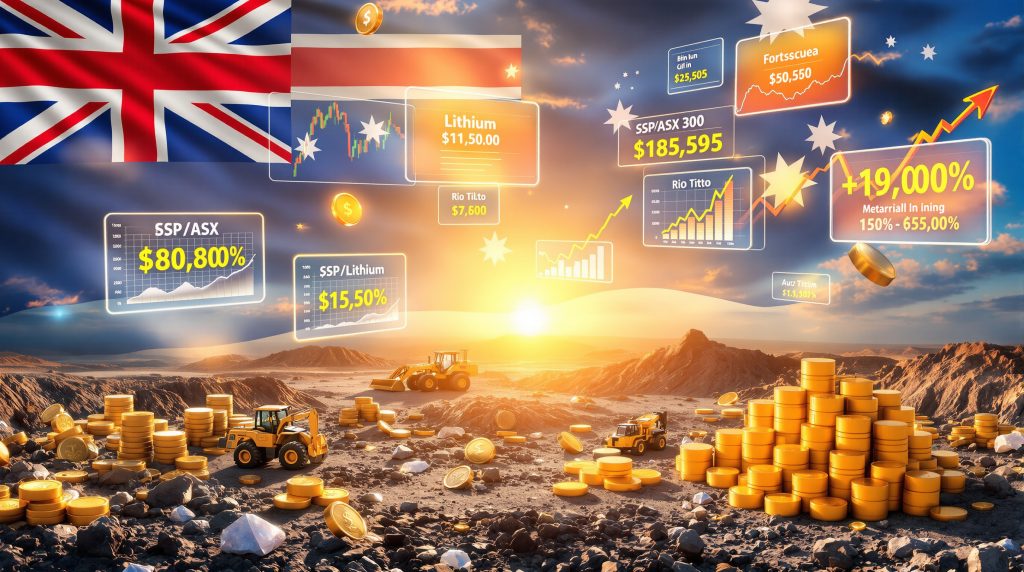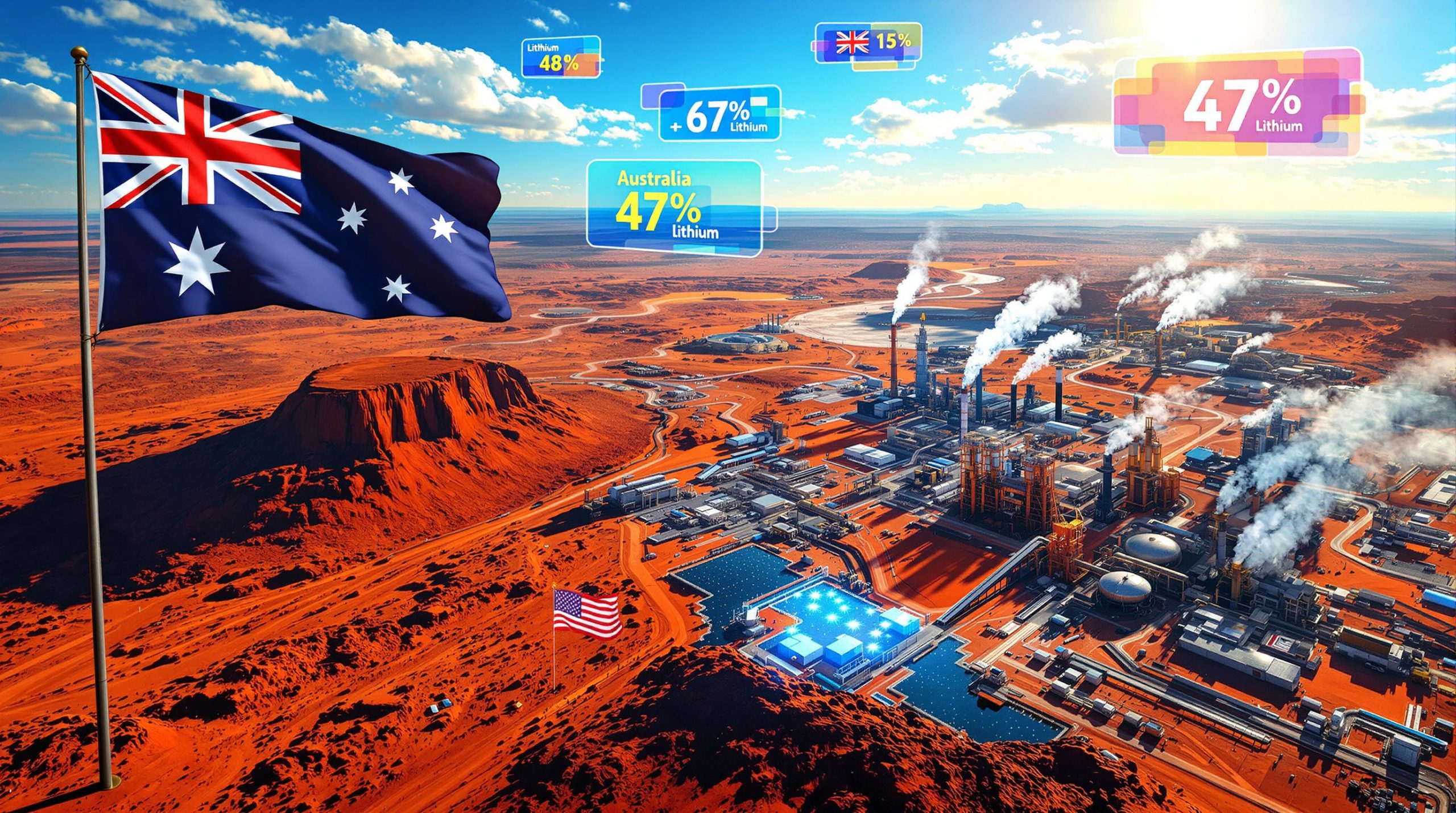How Has the ASX Mining Sector Performed in 2025?
The Australian mining sector has demonstrated remarkable resilience in 2025, with the S&P/ASX 300 Metal & Mining Index reaching record highs. Since early July, the index has surged an impressive 16.2%, significantly outpacing the broader S&P/ASX 200 Index, which gained just 5.1% during the same period. This outperformance highlights the sector's strength amid stabilizing commodity prices and changing investor sentiment.
The materials sector has been a standout performer, posting consecutive weeks of substantial gains—including a 3.65% increase followed by a 5.24% rise—resulting in cumulative growth of approximately 8.9% over a two-week period. This consistent upward trajectory reflects strong investor confidence in resource companies, supported by favorable iron ore price trends and positive demand signals.
Key Factors Driving Mining Sector Growth
Several fundamental factors have contributed to the mining sector's strong performance:
-
Iron ore price stability: The benchmark iron ore price has remained above US$100 per tonne since early July, providing crucial support for major Australian producers
-
Positive Chinese demand indicators: Stronger-than-expected industrial production data from China has reinforced investor confidence
-
Macroeconomic tailwinds: Interest rate cuts in major economies and favorable employment data have created a supportive environment for resource companies
-
Production discipline: Major miners have maintained production discipline, supporting commodity price stability
-
Investor rotation: Large institutional investors like AustralianSuper have begun rotating out of banking stocks and into resources
The sector's exceptional performance hasn't been uniform across all commodity segments or company sizes, reflecting increasing investor sophistication in evaluating mining companies based on operational fundamentals, financial strength, and strategic positioning rather than broad sector exposure.
Which ASX Mining Giants Lead the Market in 2025?
BHP Group (ASX: BHP)
BHP remains Australia's largest mining company with a market capitalization of approximately $270 billion, positioning it as a cornerstone investment for most global mining portfolios. The company's diversification across iron ore, copper, nickel, coal, and other essential commodities provides exposure to both traditional infrastructure development and emerging battery technologies.
Despite facing headwinds in 2025, with revenues down 8% and attributable profit declining 26% in its latest financial results, BHP maintains an attractive dividend yield of 5.5% and projects revenue growth of 8-10% for the year. The company's strategic pivot toward copper has been particularly notable, with BHP now positioning itself as the world's largest copper producer—a metal that contributed nearly half of its overall EBITDA in FY25.
Ord Minnett maintains an "accumulate" rating on BHP shares with a 12-month price target of $42.50, noting that the company's copper segment has delivered particularly strong performance, offsetting weaknesses in other areas.
Fortescue Ltd (ASX: FMG)
Fortescue has established itself as Australia's second-largest mining company with an estimated market capitalization of approximately $90 billion. The company has distinguished itself through industry-leading cost structures in iron ore production while simultaneously pursuing an ambitious diversification strategy into green energy projects.
Despite reporting a 41% profit decline in its FY25 results and cutting its final dividend by 33%, Fortescue shares have risen 26% since July 1, reflecting investor confidence in the company's long-term strategy and iron ore market fundamentals. The company delivered $1.39 per share in dividends for the 2024/25 financial year, making it one of the highest-yielding stocks in the ASX mining sector.
Bell Potter has recently downgraded Fortescue from "hold" to "sell" with a 12-month price target of $17.05, expressing caution about the company's valuation relative to iron ore price sustainability.
Rio Tinto (ASX: RIO)
Rio Tinto maintains its position as a global heavyweight in the iron ore sector, delivering the highest dividend payment among ASX miners at $6.33 per share for the 2024/25 financial year. The company's mature iron ore operations and diversified commodity portfolio have enabled consistent dividend distributions, though its share price performance in FY25 showed a decline of 10% from $119 to $107.13—still representing the best performance among the major mining giants during a challenging year.
What Are the Best Performing Commodity Segments in 2025?
Gold Sector: Shining Bright
The Australian gold mining sector has emerged as one of the standout performers in 2025, benefiting from macroeconomic factors including inflation concerns, geopolitical tensions, and currency debasement that traditionally drive investors toward precious metals as safe-haven assets.
Northern Star Resources has established itself as the dominant force in Australian gold mining, achieving a market capitalization of $26.4 billion and demonstrating exceptional long-term performance with a 792% share price increase over the past decade. The company's year-over-year performance has been particularly impressive, with a 45.9% gain reflecting both favorable gold prices analysis and successful operational execution.
Northern Star's half-year 2025 financial results showed an 18% increase in revenues and a remarkable 155% increase in net profit, demonstrating the company's ability to convert favorable market conditions into strong financial performance. The company paid a dividend of 50 cents per share as the ASX's largest gold producer.
Newmont Corporation (ASX: NEM) has also performed strongly, with Ord Minnett maintaining a "buy" rating and a target price of $115 following its Q2 FY25 report. The broker noted that Newmont "posted a June-quarter result that beat market and Ord Minnett expectations on production, costs, and operating earnings, and unveiled a further share buyback program of US$3 billion thanks to its strong fiscal performance."
Copper: Strategic Metal for the Energy Transition
The copper sector represents one of the most strategically important segments of the ASX mining landscape, with the metal serving as a bellwether for economic activity due to its extensive use in industrial applications, electrical infrastructure, and renewable energy systems.
BHP Group has strategically positioned itself as the world's largest copper producer, with the metal contributing 45% of the company's total underlying EBITDA in FY25. This strategic focus on copper has been reinforced through the acquisition of Oz Minerals, demonstrating BHP's commitment to expanding its exposure to this critical commodity.
Capstone Copper Corp (ASX: CSC) has emerged as an attractive mid-tier copper producer, with Macquarie maintaining an "outperform" rating and a target price of $12.50 following its Q2 FY25 report. The broker highlighted the company's Mantoverde Optimized (MV-O) expansion project in Chile, forecasting copper production to rise from 102,100 tonnes in 2025 to 147,200 tonnes in 2027.
Sandfire Resources has also demonstrated strong performance, recently reporting record revenue of US$1.2 billion for FY25 as copper output accelerated across its operations. The company's MATSA complex in Spain delivered 94,000 tonnes of copper equivalent in FY25, representing a 3% production increase from the previous year, while achieving a significant 20% year-on-year decline in production costs to US$1.54 per pound. Recent copper price insights suggest continued strength in this sector.
Lithium: Recovery and Selective Growth
The lithium sector has experienced one of the most dramatic turnarounds in the ASX mining landscape, transitioning from severe oversupply conditions and falling prices in 2023-2024 to a strong rebound throughout 2025. This recovery has been driven by surging demand for electric vehicles, energy storage solutions, and robust policy support from major economies.
Global EV sales are projected to hit 18 million units in 2025, representing a 35% increase from 2024, while battery storage for renewable energy projects continues expanding rapidly. As of mid-2025, lithium hydroxide prices have stabilized around US$28,000 per tonne, while lithium carbonate prices have reached steady levels near US$24,000 per tonne.
The recent lithium price surge has produced notably divergent results across ASX-listed lithium companies:
-
Positive performers: Sayona Mining (+30%), Mineral Resources (+16.4%), Pilbara Minerals (+15.3%), and Core Lithium (+8.3%)
-
Negative performers: Lake Resources (-30%), Liontown Resources (-9.7%), Rio Tinto (-5.7%), and IGO (-1.7%)
This divergence demonstrates that investors are increasingly focusing on companies with stronger balance sheets, operational mines already in production, and specific competitive advantages. Additionally, new lithium industry innovations are reshaping the sector's prospects.
What Dividend Opportunities Exist in ASX Mining Shares?
ASX mining shares have emerged as significant dividend generators in 2025, with established producers delivering substantial returns to shareholders despite challenging market conditions. The dividend landscape reveals a clear pattern where established iron ore and coal producers dominate the highest-yielding positions.
Top Dividend-Paying ASX Mining Shares in FY25
| Company | Dividend (per share) | Sector Focus |
|---|---|---|
| Rio Tinto | $6.33 | Iron ore, aluminum, copper |
| BHP Group | $2.50 | Diversified mining |
| Fortescue | $1.39 | Iron ore, green energy |
| Yancoal Australia | $0.52 | Thermal and metallurgical coal |
| Northern Star Resources | $0.50 | Gold |
| New Hope Corporation | $0.41 | Thermal coal |
| Evolution Mining | $0.12 | Gold |
The dividend performance of these companies demonstrates the sector's ability to generate strong cash flows during favorable commodity price environments, though investors should note that mining dividends typically fluctuate with commodity cycles and operational performance.
How Are Emerging Sectors Performing in the ASX Mining Space?
Rare Earths: Strategic Importance Growing
The rare earths sector has gained significant strategic importance in the global mining landscape, with Australian companies positioned as critical suppliers of these essential materials outside of Chinese-dominated supply chains. Rare earth elements are fundamental components for high-technology applications, including permanent magnets used in electric vehicles and renewable energy systems.
Lynas Rare Earths has established itself as Australia's largest rare earths producer and the only significant rare earth materials producer globally outside of China, achieving a market capitalization of AU$10.05 billion as of July 2025. The company's integrated delivery approach combines mining operations at its Mount Weld asset in Western Australia with processing capabilities that have been significantly expanded through strategic investments.
The November 2024 opening of Lynas' AU$800 million Kalgoorlie rare earths processing facility in Western Australia represents a major milestone in developing domestic processing capabilities and reducing dependence on overseas refining. During its fourth fiscal quarter of 2025, Lynas reported neodymium and praseodymium (NdPr) production of 2,080 tonnes, with total rare earth oxide production reaching 3,212 tonnes during the same period.
Battery Minerals: Beyond Lithium
While lithium has captured significant attention, other battery minerals are increasingly important in the ASX mining landscape. Nickel, cobalt, graphite, and manganese producers are gaining investor interest as the battery supply chain diversifies and evolves.
The battery minerals sector faces both opportunities and challenges, with price volatility and changing battery chemistries creating uncertainty for producers. However, companies with high-quality assets, strong partnerships with battery manufacturers, and flexible production capabilities are well-positioned to navigate these challenges and capitalize on the long-term growth of the electric vehicle and energy storage markets.
What Are the Key Investment Risks and Opportunities?
Investment Risks
The ASX mining sector faces several significant risks that investors should carefully consider:
-
Chinese economic slowdown: As China remains the primary consumer of many commodities, ongoing economic challenges could impact demand and pricing
-
Commodity price volatility: Mining shares remain highly sensitive to underlying commodity price movements
-
Rising production costs: Inflation in labor, energy, and equipment costs could squeeze profit margins
-
Regulatory and environmental pressures: Increasing scrutiny of mining operations and higher compliance costs
-
Geopolitical tensions: Trade disputes and supply chain disruptions could impact export markets
-
Project development risks: Cost overruns and delays in major expansion projects
-
Currency fluctuations: A strengthening Australian dollar could reduce the value of export earnings
Investment Opportunities
Despite these risks, the ASX mining sector presents compelling opportunities:
-
Energy transition exposure: Companies producing copper, lithium, nickel, and rare earths benefit from clean energy and electrification trends
-
Strong dividend yields: Established producers offer attractive income potential in a low-interest-rate environment
-
Inflation hedge: Mining shares have historically performed well during inflationary periods
-
Supply constraints: Limited new project development across many commodities could support prices
-
Strategic value: Growing recognition of the importance of secure supply chains for critical minerals
-
Valuation attractiveness: Many mining shares trade at lower price-to-earnings ratios than the broader market
-
Merger and acquisition potential: Industry consolidation could create value for shareholders
For those seeking to understand the broader context, exploring various investment opportunities 2025 can provide valuable perspective.
What Is the Outlook for ASX Mining Shares?
The outlook for ASX mining shares remains cautiously positive for the remainder of 2025 and beyond, supported by several fundamental factors:
-
Commodity price resilience: Key commodities like iron ore, copper, and gold have demonstrated price stability despite economic uncertainties
-
Production discipline: Major miners have maintained disciplined approaches to capital allocation and production volumes
-
Energy transition demand: The global push toward decarbonization continues to drive demand for critical minerals
-
Dividend sustainability: Despite some reductions, dividend yields remain attractive relative to other sectors
-
Strategic positioning: Australian miners benefit from high-quality assets, stable political environments, and proximity to Asian markets
However, investors should maintain a selective approach, focusing on companies with:
-
Strong balance sheets and cash flow generation
-
Low-cost operations positioned in the bottom half of global cost curves
-
Diversified commodity exposure or leadership positions in specific segments
-
Clear strategies for navigating the energy transition
-
Disciplined capital allocation and shareholder return policies
The sector's performance will likely continue to diverge across different commodity segments and company sizes, rewarding investors who conduct thorough due diligence and maintain a long-term perspective.
Conclusion: Navigating the ASX Mining Landscape in 2025
The ASX mining sector presents a complex but potentially rewarding investment landscape in 2025. The sector's strong recent performance, particularly in iron ore, copper, and gold segments, demonstrates its resilience and ability to generate substantial returns for shareholders despite challenging global economic conditions.
Investors should approach the sector with a balanced perspective, recognizing both the cyclical nature of commodity markets and the structural growth opportunities presented by the global energy transition. By focusing on companies with strong operational fundamentals, prudent financial management, and strategic positioning for future demand trends, investors can potentially benefit from both income generation and capital appreciation in this dynamic sector.
As global economic uncertainties persist and the energy transition accelerates, Australian mining companies are likely to play an increasingly important role in providing the essential materials needed for both traditional infrastructure development and emerging clean energy technologies. This dual exposure to both current and future demand drivers positions the sector for continued relevance in diversified investment portfolios.
Further Exploration:
Readers interested in learning more about ASX mining shares can also explore related educational content, such as The Motley Fool Australia's article on ASX mining stocks, which provides comprehensive data on the performance of mining stocks on the Australian Securities Exchange. Additionally, for those looking to dive deeper into resource companies, Stockhead's resources section offers regular updates on mining sector developments and emerging opportunities.
Ready to Spot the Next Major ASX Mineral Discovery?
Don't miss out on potential market-moving announcements that could lead to significant returns for savvy investors. Discovery Alert's proprietary Discovery IQ model delivers instant notifications on ASX mineral discoveries, helping you identify actionable opportunities before the broader market. Explore historic examples of exceptional discoveries at https://discoveryalert.com.au/discoveries/ and position yourself for success.




